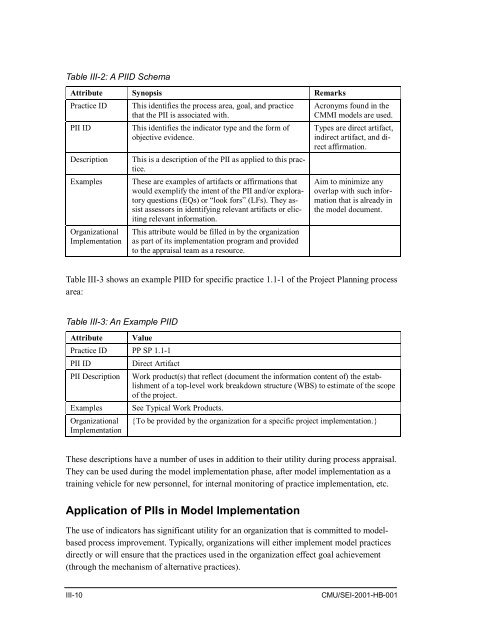Standard CMMI Appraisal Method for Process Improvement (SCAMPI)
Standard CMMI Appraisal Method for Process Improvement (SCAMPI)
Standard CMMI Appraisal Method for Process Improvement (SCAMPI)
You also want an ePaper? Increase the reach of your titles
YUMPU automatically turns print PDFs into web optimized ePapers that Google loves.
Table III-2: A PIID Schema<br />
Attribute Synopsis Remarks<br />
Practice ID<br />
PII ID<br />
Description<br />
Examples<br />
Organizational<br />
Implementation<br />
This identifies the process area, goal, and practice<br />
that the PII is associated with.<br />
This identifies the indicator type and the <strong>for</strong>m of<br />
objective evidence.<br />
This is a description of the PII as applied to this practice.<br />
These are examples of artifacts or affirmations that<br />
would exemplify the intent of the PII and/or exploratory<br />
questions (EQs) or “look <strong>for</strong>s” (LFs). They assist<br />
assessors in identifying relevant artifacts or eliciting<br />
relevant in<strong>for</strong>mation.<br />
This attribute would be filled in by the organization<br />
as part of its implementation program and provided<br />
to the appraisal team as a resource.<br />
Acronyms found in the<br />
<strong>CMMI</strong> models are used.<br />
Types are direct artifact,<br />
indirect artifact, and direct<br />
affirmation.<br />
Aim to minimize any<br />
overlap with such in<strong>for</strong>mation<br />
that is already in<br />
the model document.<br />
Table III-3 shows an example PIID <strong>for</strong> specific practice 1.1-1 of the Project Planning process<br />
area:<br />
Table III-3: An Example PIID<br />
Attribute<br />
Value<br />
Practice ID PP SP 1.1-1<br />
PII ID<br />
PII Description<br />
Examples<br />
Organizational<br />
Implementation<br />
Direct Artifact<br />
Work product(s) that reflect (document the in<strong>for</strong>mation content of) the establishment<br />
of a top-level work breakdown structure (WBS) to estimate of the scope<br />
of the project.<br />
See Typical Work Products.<br />
{To be provided by the organization <strong>for</strong> a specific project implementation.}<br />
These descriptions have a number of uses in addition to their utility during process appraisal.<br />
They can be used during the model implementation phase, after model implementation as a<br />
training vehicle <strong>for</strong> new personnel, <strong>for</strong> internal monitoring of practice implementation, etc.<br />
Application of PIIs in Model Implementation<br />
The use of indicators has significant utility <strong>for</strong> an organization that is committed to modelbased<br />
process improvement. Typically, organizations will either implement model practices<br />
directly or will ensure that the practices used in the organization effect goal achievement<br />
(through the mechanism of alternative practices).<br />
III-10<br />
CMU/SEI-2001-HB-001
















